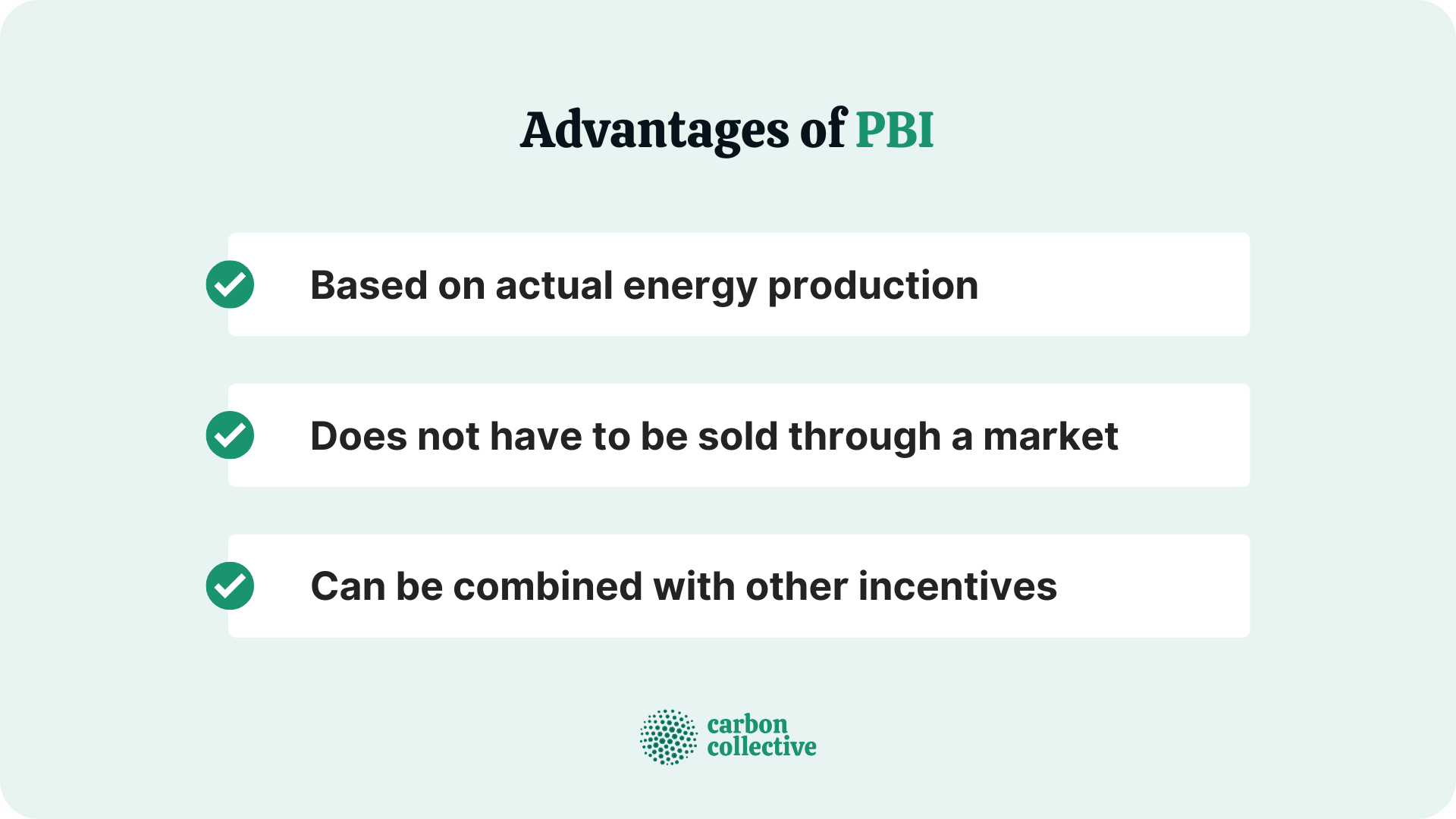What Is PBI?
A performance based incentive (PBI) is a payment made to solar system owners based on how much electricity their system generates.
PBI programs differ from SREC programs in one important way: PBI programs give an incentive for the electricity generated (i.e., the kilowatt-hours of production), while SRECs reflect the environmental benefits of solar power (emission reductions).
PBIs, unlike SRECs, are not required to be sold through a market, and incentive rates are set when the system is constructed. It can be used in place or in addition to net metering rules.
The incentive is designed to encourage solar adoption by providing a financial incentive for customers who go solar.
How It Works
PBIs are paid out based on actual energy production over a set period, usually six years, upon validation of system generation.
The utility sets the incentive amount, and the state regulator approves it. It can be a fixed dollar amount per kilowatt-hour (kWh) produced or a percentage of the customer's bill offset by the solar production.
Systems eligible for the PBI must meet certain requirements, such as being grid-connected and having a net metering agreement with the utility.
Eligibility Requirements
Only System Owners with a third-party financing structure (i.e., lease or power purchase agreement (PPA)) are eligible for a Performance Based Incentive (PBI).
Homeowners will contract eligible contractors or third party system owners to install a solar PV system.
Following a successful inspection, the PBI is paid to the System Owner over twenty-four (24) calendar quarters and is based on actual output at a per-kilowatt-hour rate determined at the time of RSIP project/incentive approval.
The estimated total PBI is expected of system owners to be incorporated into the lease or PPA fee to the client.
PBIs' Importance to Solar
PBIs are important to the solar industry because they provide a financial incentive for customers to go solar.
Proper Installation
Specifically, the PBI motivates installers and system owners to focus on proper installation, maintenance, and performance since the program incentivizes based on system output.
System owners are paid based on the amount of electricity their system generates, so it is in their best interest to ensure that the system is installed correctly and performs well.
Ensuring Proper Distribution of Incentives
Another reason PBIs are important is that they help to ensure that incentives are appropriately distributed.
It assures policymakers and regulators that the incentives are going to those who are contributing to increasing solar adoption and not being pocketed by installers or system owners.
When incentives are correctly distributed, it builds trust and confidence in the solar industry, which is important for its long-term growth.
Creates Jobs that Drive the Economy
PBIs also create jobs in the solar industry.
Because they provide a financial incentive for customers to go solar, PBIs help drive demand for solar systems.
This increased demand leads to more jobs in the solar industry, from manufacturers and suppliers to installers and system owners.
PBI Sample Computation
The following is an example of how a PBI might be calculated.
Assume that a utility offers a $0.10/kWh PBI for solar PV systems. A homeowner installs a 5-kW system, and the system produces 100 kWh in its first month of operation.
The PBI for that quarter would be $30 (300 kWh x $0.10/kWh).
Note that the PBI would be paid out to the system owner quarterly.
Advantages of PBI
Performance Based Incentives (PBI) have several advantages over other incentives, such as the Solar Renewable Energy Certificate (SREC).

-
PBIs are paid out based on actual energy production, which means that PBIs provide a more accurate representation of the value of solar to the grid and society.
-
PBIs are not required to be sold through a market and can be paid directly to the customer by the utility.
-
PBIs can also be used with other incentives, such as the SREC, to maximize solar customers' financial return on investment.
Key Takeaways
Performance Based Incentives (PBI) are a type of incentive paid out based on the actual energy production of a solar PV system.
The amount of incentive is set by the utility and approved by the state regulator and can be a fixed dollar amount per kilowatt-hour (kWh) produced or a certain percentage of the customer's bill that is offset by the solar production.
PBIs are important to the solar industry because they provide a financial incentive for customers to go solar and help to ensure that incentives are properly distributed. Moreover, it helps create jobs in the solar industry by driving demand for solar systems.
FAQs
1. What is a Performance Based Incentive (PBI)?
A PBI is a type of incentive that is paid out based on the actual energy production of a solar PV system.
2. How are PBIs paid?
PBIs can be paid out in various ways, depending on the state in which they are offered. In some states, the utility pays PBIs directly to the customer, usually six years upon validation of system generation.
3. What are the advantages of PBIs over other types of incentives?
PBIs are paid out based on actual energy production. It is not required to be sold through a market and can be paid directly to the customer by the utility. PBIs can also be used in combination with other incentives.
4. What is the difference between a PBI and an SREC?
SRECs are credits that solar PV system owners earn for every megawatt-hour (MWh) of electricity their system produces. PBIs are paid out based on the actual energy production of the solar PV system and do not require the sale of credits.
